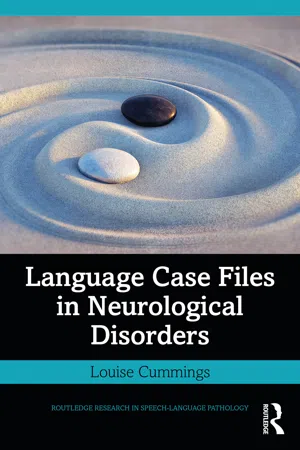
- 240 pages
- English
- ePUB (mobile friendly)
- Available on iOS & Android
Language Case Files in Neurological Disorders
About This Book
This book features case studies of ten individuals with acquired neurological disorders. These disorders have implications for speech, language, and communication, but to date they have not been the focus of research in speech-language pathology.
Chapters present a brief medical overview of each condition, followed by detailed linguistic analysis. A carefully assembled narrative captures the impact of each neurological disorder on an individual's daily life and social activities. This structured approach, supported by further reading and exercises, gives readers a nuanced understanding of each disorder's clinical presentation and language and communication features, and the complex interrelationship between language, communication, and cognitive and motor symptoms.
The book will be of interest to students of all levels, researchers, and clinicians in speech-language pathology and related disciplines, including neurology, psychiatry, and psychology.
Frequently asked questions
Information
Case Study 1
Corticobasal Degeneration
Key facts and figures:
- Corticobasal degeneration (CBD) is a tauopathy in which there is deposition of abnormal tau protein in the brain. Corticobasal syndrome (CBS), the most common phenotype, is characterised by asymmetric rigidity and apraxia, cortical sensory deficits, dystonia and myoclonus. Patients with clinical CBD can have non-CBD pathology such as Alzheimer’s pathology.1
- The prevalence of CBD is 10.84 per 100,000 and the incidence is 1.61 per 100,000. These figures are based on a population of 1.69 million in Cambridgeshire and Norfolk in England. A crude prevalence of 9 per 100,000 is reported in a rural district in Japan. The age-standardised incidence rate is 0.02 per 100,000/year in a Russian population-based study.2–4
- Age at onset and survival time in CBD have been reported in several studies. In a review of 267 nonoverlapping pathologically confirmed CBD cases from published reports and brain banks, mean age at symptom onset was 63.7 years (range 45–77.2 years) and mean disease duration was 6.6 years (range 2.0–12.5 years).5
- Motor, behavioural, cognitive and language symptoms are common in CBD. In one clinical sample of 48 patients with CBD, apraxia (93.8%) was the most common symptom followed by behavioural changes (75%), rigidity (68.8%), postural instability (66.7%), language impairment (66.7%), akinesia (62.5%), dystonia (54.2%) and supranuclear gaze paresis (45.8%).2
- Speech, language and cognitive impairments are common in CBD. In a clinical sample of 33 patients with CBS, motor speech disorder was present in 33%, agrammatism in 48% and sentence comprehension problems in 60%. Impairments of executive functions were reported in 81% of the sample.6 Language disturbances in some patients with CBD manifest as an aphasia syndrome.7
- CBD is a challenging disorder to diagnose. It can present with multiple phenotypes, and other neurodegenerative disorders with a different underlying pathology can mimic its clinical course.8
Background
Table of contents
- Cover
- Half Title
- Series Page
- Title Page
- Copyright Page
- Table of Contents
- List of Figures and Tables
- Acknowledgements
- Introduction
- Case Study 1: Corticobasal Degeneration
- Case Study 2: Progressive Supranuclear Palsy
- Case Study 3: Huntington’s Disease
- Case Study 4: Lewy Body Disease
- Case Study 5: Multiple Sclerosis
- Case Study 6: Parkinson’s Disease
- Case Study 7: Motor Neurone Disease
- Case Study 8: Alcohol-Related Brain Damage
- Case Study 9: Covid-19 Infection
- Case Study 10: Guillain-Barré Syndrome
- Conclusion
- Glossary
- Appendix
- Index